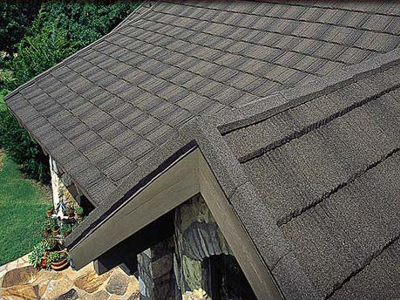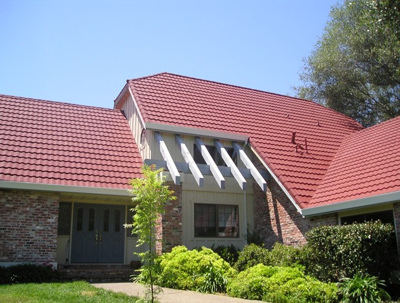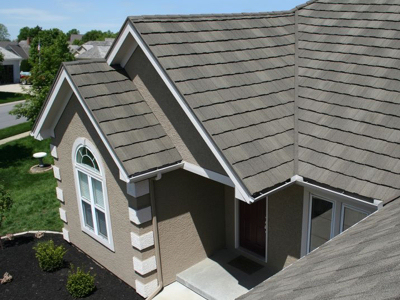By Marge O’Connor, DesignandBuildwithMetal.com
As metal roofing manufacturers continually improve the appearance and performance of their products, they are also modifying the way they educate and market to their audiences. For some products, such as specialty roofing, education is a bit more
complicated.
| Metro Roof Products | | |

| | |
| | | |
“Once someone sees our shingles, shakes, or tiles in the neighborhood it changes their outlook and they’ll buy. Since contractors benefit from referral sales, the next best thing after the first sale is for them to farm
the neighborhood for customers.” — Pete Croft, V.P. Sales and Marketing
Metro Roof Products |  | |
| | | |

| | |
| www.smartroofs.com | | |
| | | |
These systems are referred to as metal tiles, shingles, shakes, tile-facsimile, stone-coated metal roofing, or press-formed roofing. Leading manufacturers include DECRA Roofing Systems, Inc. of Corona, CA, and Metro Roof Products of Oceanside,
CA. There are others too, each with products that offer all the benefits of metal roofing with a more traditional appearance.
The market for these products is primarily residential. They also fit well in light commercial projects that need a roof with a pitch or want a look that fits into a neighborhood setting.
Although they’ve been in the U.S. market since the late 1970s, their conventional appearance keeps the fact that they’re metal nearly hidden, so few people can tell them apart from roofs made of more traditional materials. This is both
a positive and a negative.
“We’ve often said that our products are the best kept secret. That makes it difficult from a marketing aspect. On one hand it surprises people that they can find all the benefits of a metal roof without all the drawbacks of traditional
roofs. Once someone sees our shingles, shakes, or tiles in the neighborhood it changes their outlook and they’ll buy. Since contractors benefit from referral sales, the next best thing after the first sale is for them to farm the neighborhood
for customers,“ says Pete Croft, Vice President Sales and Marketing, for Metro Roof Products.
Natalie Tanner, Marketing Manager for DECRA Roofing Systems agrees it’s a marketing challenge. “Since stone coated steel roofing so closely replicates and blends with traditional roofing, consumers often mistake it for the product it replicates. Once
a consumer is made aware of our products, they often think it is something new, rather than a proven product with over fifty years on the market. Education is very important and creating awareness with consumers that metal roofing isn’t
just for commercial use is a primary objective. Schools and churches also use our stone coated steel roofing systems because their traditional appearance fits into the neighborhood while providing the longevity of metal that other materials don’t
offer.”
| DECRA Roofing Systems | | |

| | |
| | | |
“These roofs perform well in harsh environments and were first used as a solution in areas where earthquakes, fires and hail were present. California and Texas were the first big markets.” — Natalie Tanner, Marketing Manager
DECRA Roofing Systems | 
| |
| | | |

| | |
| www.decra.com | | |
| | | |
In the U.S. the majority of roofs are asphalt shingle. Although metal is growing in market share, metal still is not considered a traditional residential product by some homeowners’ associations that will not allow metal to be installed no matter
the look. Others have chosen tiles and shakes because the look blends in perfectly and the durability of metal has proven to be a benefit.
The variety of styles and the durability of specialty metal roofs in critical situations has been a factor in their regional growth.
“These roofs perform well in harsh environments and were first used as a solution in areas where earthquakes, fires and hail were present. California and Texas were the first big markets. Today Texas and other states offer insurance rebates
for impact resistant roofing. Metal roofing is lightweight and freeze/thaw resistant therefore it can be used where concrete tiles cannot because of weight or other conditions. Metal shingles are now also popular in the Midwest because of
their high performance and ease of installation. Roofers can easily learn how to install them and it allows them more options to offer their customers,” Tanner says.
The market growth is also spurred on by other elements and metal’s all-weather benefits. “In parts of Texas the image is tile, like the style popular in Florida. In those cases we’ve had success with our Roman Tile product. That
trend started right after the hurricanes that hit Florida in 2005 and 2006. In our tenth year of selling to the Midwest our products have taken on a new lease in life. Homeowners have become tired of replacing their roofs again and again and we’ve
proven the value of metal to them. Some contractors in these areas are now doing all their asphalt jobs in the summer and all their metal jobs when it’s cold because metal can go up easily in any weather. Not many contractors condoned
or acknowledged the recession, they just decided they’d get on with their life and now they’re continuing to work in the cold months,” says Croft.
Effective Distribution
Joint marketing efforts such as the work of the Metal Roofing Alliance have helped increase business. For individual manufacturers education and building relationships with good distributors has proven to be a key to opening new markets.
“There’s no magic formula. The process has been pretty much hand-to-hand with a lot of effort by individual manufacturers and distributors who work with quality contractors that typically installed a lot of asphalt roofing. Contractors
are always open to finding new products, so while we’re working on building national awareness, we rely on local distributors to penetrate new markets for us. From our standpoint direct to contractors is not a scalable concept. In
our niche industry, and metal roofing in general, a lot of distributors have taken the time to understand metal roofing and join related trade associations. Metal had been a big question mark for them but they’re now jumping on the bandwagon
because this is a growing market. You don’t see that with distributors of other materials,” says Croft.
In addition, Metro does a lot of pull-through marketing by communicating to the contractor how simple it is to sell a high-ticket item. They are also educating the consumer about the value of metal roofs by using comparisons to other roofing materials
and products.
DECRA also sells its products through distribution. “We originally sold our products directly to contractors or through specialty distributors. In 2001, when we introduced the shingle profile it changed the way we went to market. The
shingle, with its easy to install components opened up new opportunities for us to bring our products to the mainstream roofing market. Selling through distribution has also expanded our products into new areas and into the hands of a broader
base of contractors. Taking our products through traditional distribution channels has been extremely successful. Today our products are on displays and in product showrooms throughout distributors, lumberyards and some retail locations
across North America,” Tanner says.
Electronic Boost
DECRA’s marketing support has also changed. “Prior to transitioning our products through traditional distribution channels, we would develop mostly collateral materials for contractors to target consumers. Now we market to a
variety of audiences and use the Internet more to reach them. Electronic marketing also makes it easier for consumers and industry professionals to find our products. We are currently adding a new product video and a comprehensive
interactive product program to our Web site. The Internet makes it easier to provide the latest product information and training materials,” notes Tanner.
Decra also offers case studies on its Web site to help buyers as well as distributors understand the challenge and the solution. But face-to-face opportunities still play a key role in the education process. “Our products are still often
mistaken for asphalt because of the shape of some profiles and the texture of the stone coating. Touching and feeling the product is important and trade shows, distributor displays and showrooms continue to provide an opportunity for a hands
on experience,” says Tanner.
Sustainable Impact
The green movement has encouraged buyers to choose products they believe are a help to the environment. Specialty metal roofing has all the sustainable benefits of metal roofing such as recycled content, the ability to be recycled, and to be used
as a retrofit atop an old roof to keep the old roofing material from going into the landfill. They are also a water shedding product and the stone-coated steel roofs can withstand hail damage without cosmetic damage and are corrosion resistant
because they are made with 26-gauge aluminum and Galvalume coated steel.
Another aspect of the green movement, ENERGY STAR rated products, seems to be a questionable benefit.
“We kind of scratched our heads a bit when ENERGY STAR was launched. When Congress first voted in the tax credit it was only $500; but it surprised us how many consumers registered their warranties to get the rebate. It shows that anything
like this makes an impact. When it was increased to $1500 that directed the consumers toward certain colors. Now that the tax credit is back to $500 we fully expect they’ll buy based on the color they want rather than the tax credit,”
Croft says.
Tanner notes that many consumers look for ENERGY STAR materials but their intent is not always clear. “From a marketing standpoint it’s hard for us to tell whether consumers are looking for energy savings or just a tax rebate by buying
ENERGY STAR products. ENERGY STAR colors are often either very light colors or colors that carry an up charge. That’s become a challenge for many companies. The National Association of Homebuilders did a study recently that showed
homeowners are not willing to pay more than 1 percent more for a sustainable product.”
The increased emphasis on energy efficiency over the past decade has led to a few changes in products, such as DECRA’s development of its Mist Grey color. But a bigger issue is the influence of codes and standards. California has typically
been the toughest market in terms of codes and other states are tending to follow its lead. The expectation is that standards will become more stringent and mandatory in all parts of the country as an increased emphasis is placed on climate
change.
Specialty residential roofs, however, are not as affected because they are not usually custom engineered. “In California we’re used to dealing with code bodies because most of the cities require an inspection for a re-roof, which
verifies that the work is up to minimum code or local requirements. A lot of times the building code is the bare minimum for how a building must be built. With companies like ours that are focused on residential it’s not typical for
us to engineer the roof, as with standing seam products. All of our products are covered by an ICC evaluation report, so that any local inspector anywhere in the country can access the reports and inspect the roof using the details contained
in the report. So, local jurisdiction isn’t worried about our roof because it’s covered in the code report. But now that there are a wide array of modular panels it would be beneficial for us to work to expand what’s in the
code,” says Croft.
Keeping a watchful eye on codes, however, will continue to be necessary. “As performance and energy codes are adopted by states as mandatory, it can hurt our efforts in the market. However, it is a matter of education rather than product
change that is our focus. Metal is an energy efficient product and more testing is being done to support this claim. It is a matter of educating the building and home owner as to the benefits of metal beyond the color of the product, and into
the inherent properties. Additionally, homeowners in all states are becoming more educated as to the choices available. While CA is faced with Title 24, there is a performance and prescriptive path and if the performance path is chosen there
are several ways to meet the energy efficient requirements,” says Meredith England, LEED AP, Market Specialist with DECRA.
So, no matter what part of the country you’re in, you might see roofs made of metal tiles, shingles, and shakes, but you still may not be sure that they’re metal -- until you talk with the well-informed, happy homeowner.